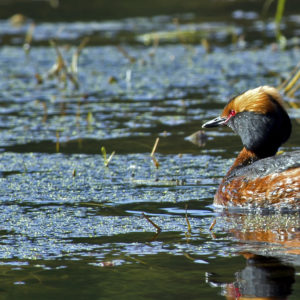How climate change is affecting birds
Egg laying is occurring earlier
One large-scale study showed that birds are laying eggs up at an average rate of 6.6 days earlier per decade.
The Common Murre in North America has advanced its breeding date 24 days per decade.
North American Tree Swallows are nesting up to 9 days earlier than 30 years ago, corresponding to an increase in average spring temperatures.
Migration times are shifting
Birds are migrating earlier in the spring. A study of 63 years of data for 96 species of bird migrants in Canada showed that 27 species have altered their arrival dates significantly, with most arriving earlier, in conjunction with warming spring temperatures.
Birds also seem to be delaying autumn departure: in a study of 13 North American passerines, 6 species were found to delay their departure dates in conjunction with global warming.
Some birds in Europe are even failing to migrate all together.
Bird behaviour and their environment are becoming mismatched
Much of a bird’s life cycle and behaviour is closely linked to cues from the environment, like changing seasons. A mismatch occurs when birds cannot shift their behaviour, such as breeding times, enough to coincide with changes in environment, such as when prey is available.
Long-distance migrants are particularly at risk of a mismatch as it is harder for them to know what conditions might be like at the end of the migration route. For example, wood warblers in North America aren’t migrating earlier from their neotropical wintering grounds, despite earlier springs in their northern breeding ranges – this risks a late arrival, after spring food sources on breeding grounds are gone.
Distributions are changing
Bird populations are expected to shift poleward, or to higher elevations, to stay with their ideal temperatures as the climate changes.
A study of 35 North American warbler species found that the range of occurrence of seven of the species (Prothonotary Warbler, Blue-winged Warbler, Golden-winged Warbler, Black-throated Gray Warbler, Pine Warbler, Hooded Warbler, and Cape May Warbler) has shifted significantly north in the past 24 years, by an average of 65 miles. None of the birds shifted to the south.
Ontario Breeding Bird Atlas data demonstrates that “southern” birds species such as Tufted Titmouse, Blue-Gray Gnatcatcher, Northern Mockingbird, and Red-bellied Woodpecker have increased in number and have expanded their range northwards in Ontario compared to 20 years ago.
These climate-induced shifts are not always a solution to coping with a warming climate. Birds on the move could be stymied in their efforts to find new ranges by fragmentation, human development, or natural geological features like large bodies of water.
Ecological communities are disrupted
Global warming can change entire ecological communities. Food and nesting material that birds depend on may no longer be there. Birds may face new prey, parasites, competitors, and predators to which they are not adapted.
In the northern Hudson Bay area, mosquitoes now reach peak numbers earlier in the spring. Thick-billed Murres breeding in the area have not adjusted their behaviour, and the combination of heat and mosquitoes is causing higher egg loss and greater adult mortality.
Parts of southwestern Ontario may end up with 14 fewer species of warblers than are currently found there. This could lead to increased outbreaks of some forest pests like spruce budworms.
2005 saw unprecedented failures of colonies of seabirds on the Pacific coast of North America. Only 8% of the Cassin’s Auklets nesting on Triangle Island were successful. This is because late northerly winds delayed coastal upwelling, which affected plankton growth and caused a decline in the fish species on which the seabirds depend.
Tufted Puffins at Canadian sites have breeding success near zero when water is at its warmest, which could mean that Canada’s largest breeding colony for this species, Scott Island Marine National Wildlife Area would become unsuitable for Tufted Puffins if water continues to warm.
Extinction risks are on the rise
Birds most at risk of extinction from climate change are those with restricted ranges, poor ability to move their range, small populations, or those already facing conservation challenges.
Migratory birds are particularly vulnerable to climate change effects, because they depend on multiple habitats and sites.
Arctic birds are particularly vulnerable – warming is occurring rapidly here, and at least 85 of the world’s bird species breed in global Arctic regions. Vast areas of habitat, including tundra and sea ice, will be lost. Sea ice retreat could have severe consequences for Ivory Gulls, which forage along sea ice. Canadian Ivory Gulls have already declined in number by 90% over the past two decades.
Conclusions
- Climate change is now affecting bird species’ behaviour, ranges and population dynamics;
- Some bird species are already experiencing negative impacts; and
- In the future, climate change will put large numbers of birds at risk of extinction.



